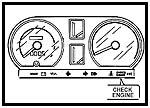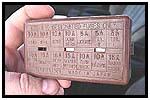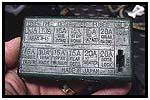 with Bill Johnston
with Bill Johnston
Check Engine Light Basics
You are driving down the road to work, it’s a beautiful day, the Zook is running great and it is turning heads because you left the top and doors at home. You drop down off the interstate and slow down to a stop at the light. Everything is going great. The light turns green, you head for the office without a care in the world. Then it happens. The ‘Check Engine’ light comes on. No changes in the sound of the motor, no sparks or plumes of smoke, not even a change in the gauges and dummy lights. Your heart races as you know you are almost at the office now, and for the life of you, you can’t figure out what the light is warning you about!

 The good news is that if your odometer just hit a ‘milestone’, it means the emission system is functioning properly. The earlier Samurai has milestones at 60,000 miles, 120,000 miles, and so on. The newer (EFI) Samurai has a different set of milestones (note the 80,000 mile milestone on the right).
The good news is that if your odometer just hit a ‘milestone’, it means the emission system is functioning properly. The earlier Samurai has milestones at 60,000 miles, 120,000 miles, and so on. The newer (EFI) Samurai has a different set of milestones (note the 80,000 mile milestone on the right).
The ‘Check Engine’ light is found on the lower light bar on Zooks with a factory tachometer. For those with the standard gauge cluster it is found in the center column between the gauges. Unless you pay attention when you start it up, most folks don’t know where it is until it comes on. Usually at the most inconvenient time.


 To turn off the light, it is as simple as flipping a switch. There is a two way switch located behind and below the ignition switch. Click on the pix to get a better idea as to what you are looking for. When the light comes on again (after another 60,000 miles or so), you just have to flip it back the other way. If the light just won’t go away, then you have a real problem that you will have to troubleshoot.
To turn off the light, it is as simple as flipping a switch. There is a two way switch located behind and below the ignition switch. Click on the pix to get a better idea as to what you are looking for. When the light comes on again (after another 60,000 miles or so), you just have to flip it back the other way. If the light just won’t go away, then you have a real problem that you will have to troubleshoot. 
 The Carbed Samurai (early) has a flow chart that will take you through the hoops. But on the EFI Samurai there is a flash code that can tell you the problem in seconds. If you don’t know what you have, look at the fuse box. The early cover is on the left, the newer cover is on the right. On the newer cover you will notice the opening in the lower right corner that says ‘DIAG’. Ok, you will probably have to click on the picture to see it…
The Carbed Samurai (early) has a flow chart that will take you through the hoops. But on the EFI Samurai there is a flash code that can tell you the problem in seconds. If you don’t know what you have, look at the fuse box. The early cover is on the left, the newer cover is on the right. On the newer cover you will notice the opening in the lower right corner that says ‘DIAG’. Ok, you will probably have to click on the picture to see it…
Here is a quick code explanation that was sent to me a few years ago.
To translate the codes on the EFI model. turn on the ignition switch and make sure that the “Check Engine” light comes on. While ignition switch is on, insert a spare fuse into the DIAG slot in the fuse panel. Observe the “Check Engine” light. It will flash out any stored trouble codes.
The trouble codes are communicated as a series of flashes on the “Check Engine” light. The codes are two digits, which are communicated as a group of .03 second flashes, with a .03 second pause between the flashes, and a 1 second pause between digits. The code will repeat itself three times, with a 3 second pause between repetitions, then it will continue to the next code (if any).
So…if one dot is equal to .1 second (for the purpose of putting this pattern into writing), and you saw FLASH…FLASH………FLASH, it would read 21.
Code Item
13 O2 Sensor
14 Water (Coolant) Temperature Sensor
15 Water (Coolant) Temperature Sensor
21 Throttle Position Sensor
22 Throttle Position Sensor
23 Air Temperature Sensor
25 Air Temperature Sensor
24 Vehicle Speed Sensor
31 Pressure Sensor (MAP)
32 Pressure Sensor (MAP)
41 Ignition Signal
42 Crank Angle Sensor
44 Idle Switch (TPS)
45 Idle Switch (TPS)
51 EGR System (California Only)
53 Ground Circuit (California Only)
54 5th Gear Switch (Non-California Only)
71 Test Switch Terminal
Steady ON ECM
12 Normal (No Trouble Codes Detected)
I hope this helps, or at least puts some of your fears at rest the next time it happens to you. May all your codes be a 12.
08/11/10 15:00:23